InPCB design, in fact, before the formal wiring, it has to go through a very long step. The following is the main design process:
1. System Specifications
First, we must first plan out the various system specifications of the electronic equipment. Including system functions, cost constraints, size, operating conditions, and so on.
2. System function block diagram
Next, the functional block diagram of the system must be produced. The relationship between the blocks must also be marked.
3. Divide the system into several PCBs
If the system is divided into several PCBs, not only the size can be reduced, but also the system has the ability to upgrade and exchange parts. The system function block diagram provides the basis for our division. For example, a computer can be divided into a motherboard, a graphics card, a sound card, a floppy disk, a power supply, and so on.
4. Decide on the packaging method and the size of each PCB

When the technology and the number of circuits used in each PCB are determined, the next step is to determine the size of the board. If the design is too large, then the packaging technology must be changed or re-divided. When choosing a technology, the quality and speed of the circuit diagram must also be considered.
5. Draw the circuit overview of all PCBs
The outline drawing should show the details of the interconnection between the parts. All PCBs in the system must be traced. Nowadays, CAD (Computer Aided Design) is mostly used.
PCB overview
The simulation operation of the preliminary design is to ensure that the designed circuit diagram can operate normally, which must be simulated once with computer software. This type of software can read the overview and display the operation of the circuit in many ways. This is much more efficient than actually making a sample PCB and then manually measuring it.
Place the part on the PCB
The way the parts are placed is determined based on how they are connected. They must be connected to the path in the most efficient way. The so-called efficient wiring is that the shorter the wire and the fewer the number of layers through (this also reduces the number of vias), the better, but we will mention this issue again when we are actually wiring. The following is how the bus bar is routed on the PCB. In order for each part to have perfect wiring, the placement position is very important.
Test wiring possibilities and correct operation at high speed
Some computer software nowadays can check whether the position of each part can be connected correctly, or check whether it can work correctly under high-speed operation. This step is called arranging parts, but we will not study them too deeply. If there is a problem with the circuit design, you can rearrange the position of the parts before exporting the circuit on the spot.
Export circuit on PCB
The connections in the overview map will now be made on the spot as wiring. This step is usually fully automatic, but in general, some parts need to be changed manually. Below is a sample wire for a 2-layer board. The red and blue lines respectively represent the part layer and solder layer of the PCB. The white text and squares represent the markings on the screen printing surface. The red dots and circles represent drill holes and pilot holes. On the far right, you can see gold fingers on the soldering surface of the PCB. The final composition of this PCB is usually called an artwork.
Every design must comply with a set of regulations, such as the minimum reserved gap between the lines, the minimum line width, and other similar practical restrictions. These regulations vary according to factors such as the speed of the circuit, the strength of the transmitted signal, the sensitivity of the circuit to power consumption and noise, and the quality of materials and manufacturing equipment. If the current intensity increases, the thickness of the wire must also increase. In order to reduce the cost of the PCB circuit board, while reducing the number of layers, it is also necessary to pay attention to whether these regulations are still in compliance. If a structure with more than 2 layers is required, then the power layer and ground layer are usually used to prevent the transmission signal on the signal layer from being affected, and can be used as a protective cover for the signal layer.